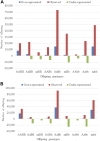Parent-offspring genotyped trios unravelling genomic regions with gametic and genotypic epistatic transmission bias on the cattle genome
- PMID: 37091801
- PMCID: PMC10117652
- DOI: 10.3389/fgene.2023.1132796
Parent-offspring genotyped trios unravelling genomic regions with gametic and genotypic epistatic transmission bias on the cattle genome
Abstract
Several biological mechanisms affecting the sperm and ova fertility and viability at developmental stages of the reproductive cycle resulted in observable transmission ratio distortion (i.e., deviation from Mendelian expectations). Gene-by-gene interactions (or epistasis) could also potentially cause specific transmission ratio distortion patterns at different loci as unfavorable allelic combinations are under-represented, exhibiting deviation from Mendelian proportions. Here, we aimed to detect pairs of loci with epistatic transmission ratio distortion using 283,817 parent-offspring genotyped trios (sire-dam-offspring) of Holstein cattle. Allelic and genotypic parameterization for epistatic transmission ratio distortion were developed and implemented to scan the whole genome. Different epistatic transmission ratio distortion patterns were observed. Using genotypic models, 7, 19 and 6 pairs of genomic regions were found with decisive evidence with additive-by-additive, additive-by-dominance/dominance-by-additive and dominance-by-dominance effects, respectively. Using the allelic transmission ratio distortion model, more insight was gained in understanding the penetrance of single-locus distortions, revealing 17 pairs of SNPs. Scanning for the depletion of individuals carrying pairs of homozygous genotypes for unlinked loci, revealed 56 pairs of SNPs with recessive epistatic transmission ratio distortion patterns. The maximum number of expected homozygous offspring, with none of them observed, was 23. Finally, in this study, we identified candidate genomic regions harboring epistatic interactions with potential biological implications in economically important traits, such as reproduction.
Keywords: Holstein; allelic and genotypic parameterizations; epistasis; genotyped trios; transmission ratio distortion.
Copyright © 2023 Id-Lahoucine, Casellas, Miglior, Schenkel and Cánovas.
Conflict of interest statement
The authors declare that the research was conducted in the absence of any commercial or financial relationships that could be construed as a potential conflict of interest.
Figures
Similar articles
-
Distortion of Mendelian segregation across the Angus cattle genome uncovering regions affecting reproduction.Sci Rep. 2023 Aug 17;13(1):13393. doi: 10.1038/s41598-023-37710-z. Sci Rep. 2023. PMID: 37591956 Free PMC article.
-
Unravelling transmission ratio distortion across the bovine genome: identification of candidate regions for reproduction defects.BMC Genomics. 2023 Jul 8;24(1):383. doi: 10.1186/s12864-023-09455-6. BMC Genomics. 2023. PMID: 37422635 Free PMC article.
-
Discovering lethal alleles across the turkey genome using a transmission ratio distortion approach.Anim Genet. 2020 Dec;51(6):876-889. doi: 10.1111/age.13003. Epub 2020 Oct 1. Anim Genet. 2020. PMID: 33006154 Free PMC article.
-
Genomic screening of allelic and genotypic transmission ratio distortion in horse.PLoS One. 2023 Aug 9;18(8):e0289066. doi: 10.1371/journal.pone.0289066. eCollection 2023. PLoS One. 2023. PMID: 37556504 Free PMC article.
-
Unravelling the genetics of non-random fertilization associated with gametic incompatibility.Sci Rep. 2022 Dec 24;12(1):22314. doi: 10.1038/s41598-022-26910-8. Sci Rep. 2022. PMID: 36566278 Free PMC article.
Cited by
-
Unraveling genomic regions with transmission ratio distortion harboring putative lethal alleles and their biological implications in Nellore cattle from experimental selection lines.J Anim Sci. 2025 Jan 4;103:skaf208. doi: 10.1093/jas/skaf208. J Anim Sci. 2025. PMID: 40574678 Free PMC article.
References
-
- Ballinger M. A., Noor M. A. F. (2018). Are lethal alleles too abundant in humans? 2018. Trends Genet. 34, 87–89. - PubMed
-
- Bateson W. (1909). “Heredity and variation in modern lights,” in Darwin and modern science. Editor Seward A. C. (Cambridge, MA, United Kingdom: Cambridge University Press; ), 85–10.
-
- Behrouzi P., Wit E. C. (2018). Detecting epistatic selection with partially observed genotype data by using copula graphical models. J. R. Stat. Soc. C 68, 141–160. 10.1111/rssc.12287 - DOI
LinkOut - more resources
Full Text Sources


